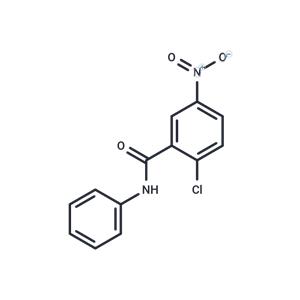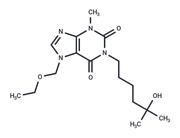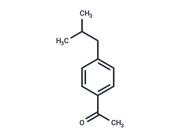| Name | GW9662 |
| Description | GW9662 (TIMTEC-BB SBB006523) is a specific PPARγ antagonist (IC50: 3.3 nM, in a cell-free assay), with 100 to 1000-fold functional selectivity for PPARγ than PPARα/δ in cells. |
| Cell Research | MDA-MB-231 cells are seeded at a density of 1 × 105 cells per 25 cm3 tissue culture flask. After 24 h (day 0), the growth medium is replaced with fresh medium containing rosiglitazone (50 μM), GW9662 (10 μM) or both together. Control flasks receives 0.1% DMSO. Cells are harvested on days 0, 3, 5, 7, 10 for each treatment condition by trypsinisation, stained using trypan blue, and the total and viable number of cells per flask calculates using a haemocytometer.(Only for Reference) |
| Kinase Assay | Binding assay: The human PPARα, PPARγ, and PPARδ ligand binding domains (LBDs) are expressed in E. coli as polyhistidine-tagged fusion proteins. Receptors are immobilized on SPA beads by addition of the desired receptor (15 nM) to a slurry of streptavidin-modifed SPA beads (0.5 mg/mL) in assay buffer. The mixture is allowed to equilibrate for at least 1 hour at room temperature, and the beads are pelleted by centrifugation at 1×103 g. The supernate is discarded, and the beads are resuspended in the original volume of fresh assay buffer with gentle mixing. The centrifugation/resuspension procedure is repeated, and the resulting slurry of receptor-coated beads is used immediately or stored at 4 ℃ for up to 1 week before use. [3H]GW2443 are used as radioligands for determination of competition binding to PPARα, PPARγ, and PPARδ, respectively. Unless otherwise indicated, the buffer used for all assays is 50 mM HEPES (pH 7), 50 mM NaCl, 5 mM CHAPS, 0.1 mg/mL BSA, and 10 mM DTT. For some experiments, the HEPES (pH 7) is replaced with 50 mM Tris (pH 8). |
| In vitro | GW9662 inhibits the activation of PPARγ and suppresses the growth of human breast cancer cell lines (MCF7, MDA-MB-468, MDA-MB-231) with IC50 values of 20-30 μM. It binds to Cys(285) on PPARγ, a site conserved across the three types of PPAR. When used alongside Rosiglitazone (50 μM) for seven days in MDA-MB-231 cells, a statistically significant reduction in cell viability is observed. In primary mouse bone marrow and RAW264.7 cells, GW9662 (2 μM) can concentration-dependently reverse the inhibitory effects of PPARγ1 ligands on RANKL-induced osteoclastogenesis. Additionally, GW9662 (1 μM) inhibits RANKL-activated NF-κB in RAW264.7 cells, and at a concentration of 2 μM, it blocks the suppressive effect of IL-4 on osteoclastogenesis in BM cells. In primary preadipocytes from patients with thyroid eye disease, GW9662 (10 μM) inhibits hormone and agonist-induced adipocyte differentiation. |
| In vivo | Pretreatment with lipopolysaccharide (1 mg/kg, i.p.) significantly mitigates all characteristics of ischemia/reperfusion injury manifesting as renal damage and dysfunction in rats. However, this protective effect of lipopolysaccharide can be inhibited by GW9662 (1 mg/kg, i.p.). |
| Storage | Powder: -20°C for 3 years | In solvent: -80°C for 1 year | Shipping with blue ice. |
| Solubility Information | DMSO : 45 mg/mL (162.64 mM), Sonication is recommended.
Ethanol : 6.9 mg/mL (25 mM)), Heating is recommended.
|
| Keywords | GW9662 | Peroxisome proliferator-activated receptors | PPAR | TIMTEC-BB SBB 006523 | TIMTEC-BB SBB-006523 | Inhibitor | inhibit | GW-9662 |
| Inhibitors Related | PHYTOL | Daidzein | Gemfibrozil | Fenofibrate | Pioglitazone hydrochloride | 5-Aminosalicylic Acid | Naringenin | Fisetin | 2,3-Butanediol | Icariin |
| Related Compound Libraries | Nuclear Receptor Compound Library | Glycometabolism Compound Library | Anti-Pancreatic Cancer Compound Library | Anti-Neurodegenerative Disease Compound Library | Bioactive Compound Library | Anti-Alzheimer's Disease Compound Library | Inhibitor Library | Anti-Aging Compound Library | Bioactive Compounds Library Max | Anti-Metabolism Disease Compound Library |

 United States
United States



